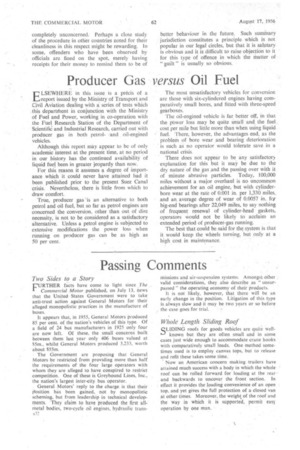Producer Gas versus Oil Fuel ELSEWHERE in this issue is
Page 34

If you've noticed an error in this article please click here to report it so we can fix it.
a précis of a IL report issued by the Ministry of Transport and Civil Aviation dealing with a series of tests which • this departrhent in conjunction with the Ministry of Fuel and Power, working in co-operation with the Fuel Research Station of the Department of Scientific and Industrial Research, carried out with producer gas in both petroland oil-engined vehicles.
Although this report may appear to be of only academic interest at the present time, at no period in our history has the continued availability of liquid fuel been in greater jeopardy than now.
For this reason it assumes a degree of importance which it could never have attained had it been published prior to the present Suez Canal crisis. Nevertheless, there is little from which to draw comfort.
True, producer gas 'is an alternative to both petrol and oil fuel, but so far as petrol engines are concerned the conversion, other than out of dire necessity, is not to be considered as a satisfactory alternative. Unless a petrol engine is subjected to extensive modifications the power loss when running on producer gas can be as high as 50 per cent. The most unsatisfactory vehicles for conversion arc those with six-cylindered engines having comparatively small bores, and fitted with three-speed gearboxes.
The oil-engined vehicle is far better off, in that the power loss may be quite small and the fuel. cost per mile but little more than when using liquid fuel. There, however, the advantages end, as the problem of bore wear and bearing deterioration is such as no operator would tolerate save in a national crisis.
There does not appear to be any satisfactory explanation for this but it may be due to the dry nature of the gas ,and the passing over with it of minute abrasive particles. Today, 100,000 miles without a major overhaul is no uncommon achievement for an oil engine, but with cylinderbore wear at the rate of 0.001 in. per 1,330 miles, and an average degree of wear of 0.0057 in. for big-end bearings after 22,049 miles, to say nothing of frequent renewal of cylinder-head gaskets, operators would not be likely to acclaim an extended period of producer-gas running.
The best that could be said for the system is that it would keep the wheels turning, but only at a high cost in maintenance.




































































































